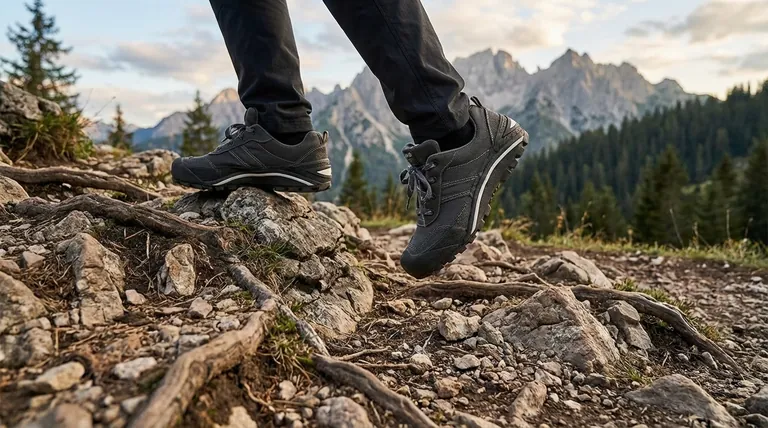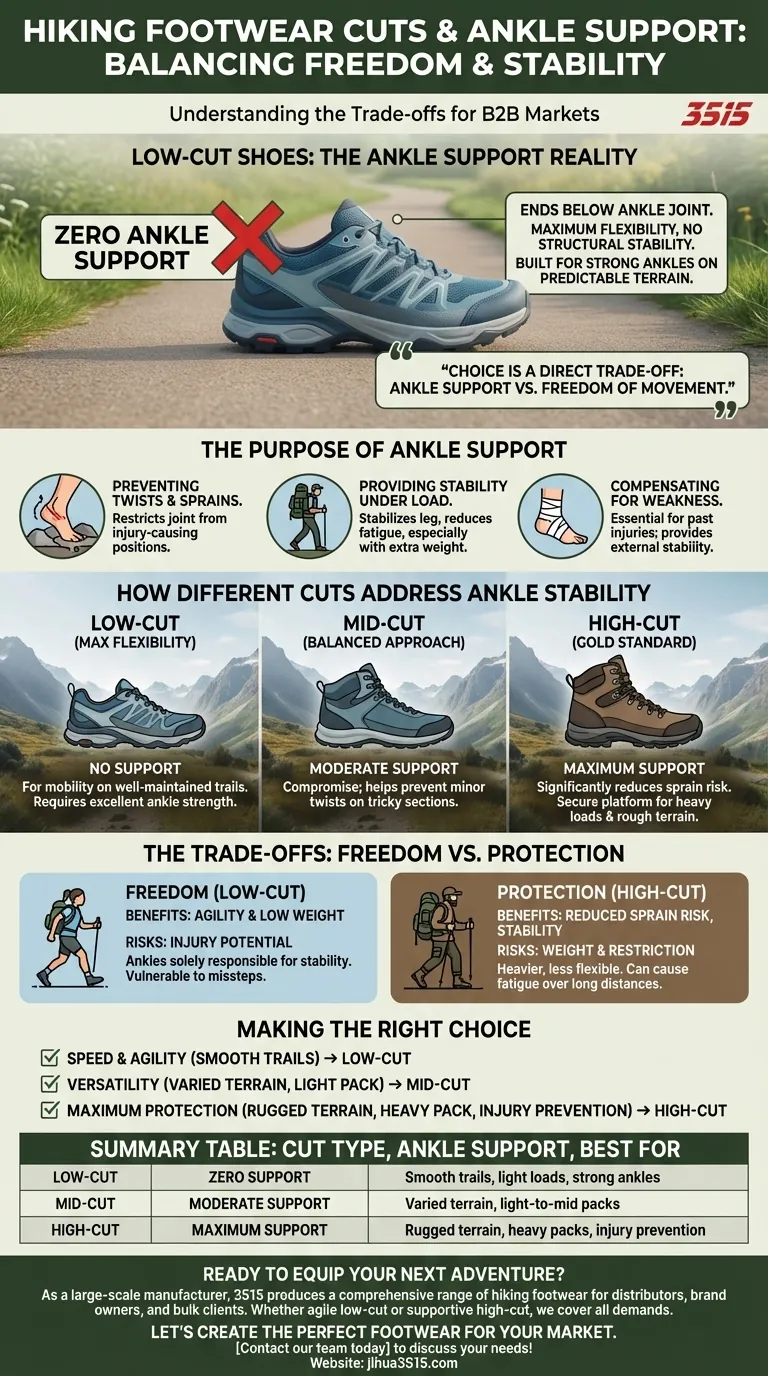Regarding ankle support, the defining characteristic of low-cut hiking shoes is its complete absence. These shoes are designed like a standard running or trail shoe, ending below the ankle joint, which offers maximum flexibility but provides no structural stability to prevent twists or sprains. They are built for hikers with strong, stable ankles who stick to mostly smooth and predictable surfaces.
The choice in hiking footwear is a direct trade-off between ankle support and freedom of movement. Low-cut shoes prioritize agility and low weight by eliminating ankle support, while higher-cut boots sacrifice some of that freedom to provide crucial stability and protection.

The Purpose of Ankle Support in Hiking Footwear
Ankle support is a critical feature in footwear designed for navigating challenging environments. Its primary purpose is to protect the ankle joint from injury.
Preventing Twists and Sprains
On uneven, rugged, or rocky terrain, the risk of rolling an ankle is significant. Footwear that covers and supports the ankles helps to maintain proper joint alignment and physically restricts the joint from moving into an injury-causing position.
Providing Stability Under Load
Ankle support becomes even more vital when carrying a heavy backpack. The extra weight raises your center of gravity and increases the forces on your joints, making a sprain more likely. A supportive boot helps stabilize your entire leg, reducing fatigue and the risk of a misstep.
Compensating for Weakness or Past Injury
For individuals with a history of ankle injuries, supportive footwear is essential. Damaged ligaments can impair proprioception—the body's ability to sense its position in space—making it harder to react to unstable ground. A high-cut boot provides external stability that the body may no longer be able to provide on its own.
How Different Cuts Address Ankle Stability
The height of the shoe's "cut" or collar is the primary determinant of its ability to support your ankle.
Low-Cut Shoes: Maximum Flexibility, Zero Support
As established, low-cut shoes offer no support. They are designed for mobility and are best suited for well-maintained trails where the risk of an ankle roll is minimal. Their use requires the hiker to possess excellent ankle strength and stability.
Mid-Cut Shoes: A Balanced Approach
Mid-height footwear offers a compromise. The collar rises to the base of the ankle bones, providing moderate support that can help prevent minor twists on tricky trail sections. However, they do not offer the same lockdown security as a full boot.
High-Cut Boots: The Gold Standard for Support
High-cut boots feature a tall shaft that fully envelops and stabilizes the ankle joint. This design significantly reduces the risk of sprains, provides a secure platform for carrying heavy loads, and is the recommended choice for rough terrain.
Understanding the Trade-offs: Support vs. Mobility
Choosing hiking footwear isn't about finding the "best" shoe, but the right tool for the job. This involves understanding the fundamental trade-offs.
The Cost of Support: Weight and Restriction
The primary downside of high-cut, supportive boots is that they are heavier and less flexible than low-cut shoes. This can lead to greater fatigue over long distances and a feeling of being less nimble on the trail.
The Risk of Freedom: Injury Potential
The freedom and light weight of low-cut shoes come at a price: vulnerability. Without any external support, your ankles are entirely responsible for maintaining stability. One misplaced step on a rock or root can easily lead to a debilitating sprain.
Making the Right Choice for Your Hike
Select your footwear by matching its level of support to the terrain you will be hiking and your own physical condition.
- If your primary focus is speed and agility on well-maintained trails: A low-cut shoe is the ideal choice, offering maximum freedom of movement.
- If your primary focus is versatility for varied terrain with a light pack: A mid-cut shoe provides a good balance of moderate support and flexibility.
- If your primary focus is maximum protection on rugged, unpredictable terrain or when carrying a heavy pack: A high-cut boot is the only safe and appropriate option.
Understanding this balance between freedom and protection is the key to choosing footwear that empowers your every step on the trail.
Summary Table:
| Cut Type | Ankle Support Level | Best For |
|---|---|---|
| Low-Cut | Zero Support | Smooth trails, light loads, strong ankles |
| Mid-Cut | Moderate Support | Varied terrain, light-to-mid packs |
| High-Cut | Maximum Support | Rugged terrain, heavy packs, injury prevention |
Ready to Equip Your Next Adventure?
As a large-scale manufacturer, 3515 produces a comprehensive range of hiking footwear for distributors, brand owners, and bulk clients. Whether your customers need agile low-cut shoes for light trails or supportive high-cut boots for rugged terrain, our production capabilities cover all types of shoes and boots to meet any demand.
Let’s create the perfect footwear for your market. Contact our team today to discuss your needs and explore our catalog!
Visual Guide

Related Products
- Durable Rubber Sole Outdoor Shoes Wholesale & Custom Manufacturing
- Durable Waterproof Rain Boots | Custom Manufacturer for Wholesale & Brands
- Safety Footwear Wholesale Manufacturer for Custom OEM/ODM Production
- Durable Rubber-Soled Utility Shoes for Wholesale & Custom Brand Manufacturing
- Custom OEM Training Shoes Wholesale Manufacturer Durable & Breathable
People Also Ask
- How does cushioning work in hiking shoes? The Science of Shock Absorption
- Why are vulcanized soles popular in urban fashion? Discover the Legacy of Authentic Street Style
- What were traditional shoe soles made from before rubber? The History of Leather Soles
- What are some alternatives to hunting boots? Hiking, Rubber & Tactical Boots Explained
- Why are rubber-soled shoes considered multi-weather footwear? Unlock All-Season Traction & Protection



















